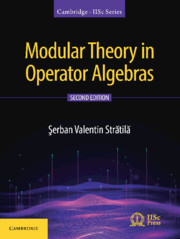Book contents
- Frontmatter
- Dedication
- Contents
- Preface to the Second Edition
- Preface to the First Edition
- Chapter I Normal Weights
- Chapter II Conditional Expectations and Operator-Valued Weights
- Chapter III Groups of Automorphisms
- Chapter IV Crossed Products
- Chapter V Continuous Decompositions
- Chapter VI Discrete Decompositions
- Appendix
- References
- Notation Index
- Subject Index
Chapter III - Groups of Automorphisms
Published online by Cambridge University Press: 16 October 2020
- Frontmatter
- Dedication
- Contents
- Preface to the Second Edition
- Preface to the First Edition
- Chapter I Normal Weights
- Chapter II Conditional Expectations and Operator-Valued Weights
- Chapter III Groups of Automorphisms
- Chapter IV Crossed Products
- Chapter V Continuous Decompositions
- Chapter VI Discrete Decompositions
- Appendix
- References
- Notation Index
- Subject Index
Summary
Groups of Isometries on Banach Spaces
In this section, we describe the general framework for the spectral analysis of groups of isometrics on Banach spaces.
Let be a Banach space and a closed linear subspace. Besides the norm topologies, we shall also consider the weak topologies on and on. Consider the following conditions on the pair:
Lemma 1. Let be a pair-satisfying conditions and a bounded regular Borel measure on a separable locally compact Hausdorff space S. For every w-continuous norm-bounded function x there exists a unique element such that
Proof. The equation
defines a linear form on. To prove the lemma it is sufficient to show that is - continuous or, equivalently, that f is continuous with respect to the Mackey topology. Thus, we have to show that there exist an absolutely convex w-compact set and such that
We first assume that C = supp is compact. Then we have
Since C is compact and is w-continuous, the set is w-compact. Then the set is w-compact, and hence is absolutely convex and w-compact by condition (2). Since, inequality (2) follows from (3).
In the general case, there exists an increasing sequence of compact subsets of S such that. By the first part or the proof, there exist such that
Then, for every we have
and using condition it follows that is a Cauchy sequence in. If is the limit of this sequence, it then follows from (4) that for all .
The uniqueness of the element satisfying (1) follows obviously using (1x).
The unique element satisfying (1) will be denoted by
Consider now two pairs and satisfying conditions and. Let be the Banach space or all bounded linear operators and the linear space or all w-continuous linear operators. Using the Banach–Steinhauss theorem, it is easy to check that is a norm-closed linear subspace. In particular, is a Banach space.
- Type
- Chapter
- Information
- Modular Theory in Operator Algebras , pp. 159 - 228Publisher: Cambridge University PressPrint publication year: 2020

